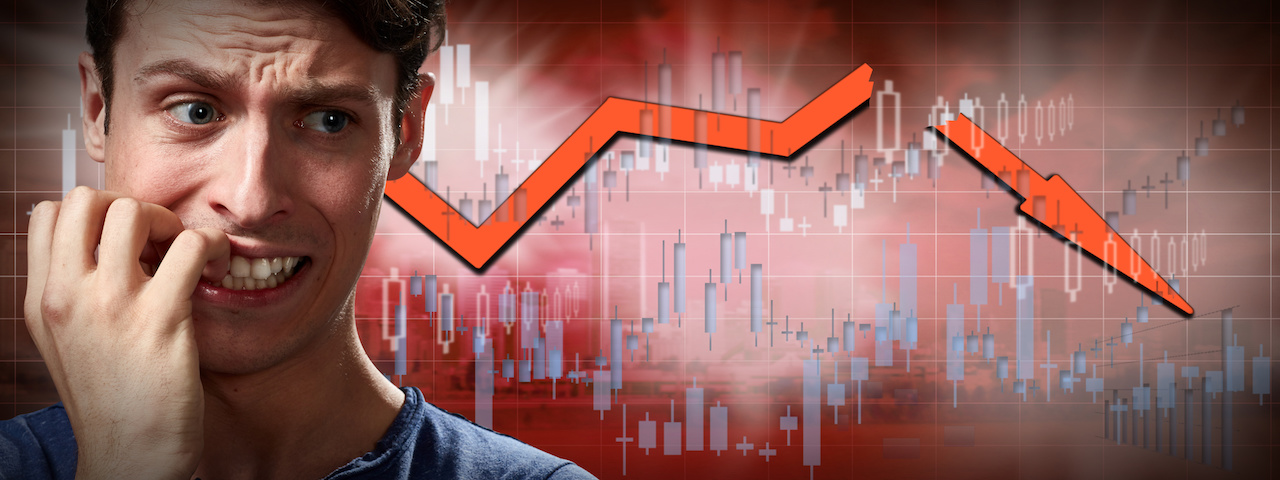Credit Sesame reported on Saturday that stock market losses continue. Why is this happening?
Extended slumps in the stock market are always cause for investor angst. Given how much is riding on stocks these days, the sweaty palms and knotted stomachs may be especially severe this time around.
A new report showed that household net worth has grown more dependent on stocks in recent years. With stocks off to a very rough start in the early months of this year, a wide cross-section of Americans is feeling the impact.
Falling Stocks Better Net Worth
In years past, you might have thought stock market news was something only fat-cat investors needed to worry about. These days though, Main Street America is almost as heavily invested in stocks as Wall Street.
For U.S. households and nonprofit organizations, the percentage of financial assets invested in stocks reached an all-time high at the end of 2021. This is based on data from the St. Louis Federal Reserve Bank that goes back to 1951.
Financial assets include all forms of savings and investments – everything from bank accounts to retirement funds. As of December 31, 2021 stocks represented 41.93% of financial assets. That record high is up sharply from 25.18% ten years ago.
This means many people went into this year with more money than ever depending on stocks. The way 2022 is shaping up, it looks like this was a bad time to have so much riding on the stock market.
Stocks Are On Pace for a Very Bad 2022
Over the first four months of 2022, the S&P 500 dropped by nearly 13%.
That’s the stock market’s worst start to a year in decades. That includes the years of the dot-com collapse, the 2008 financial crisis and the onset of the COVID-19 pandemic in 2020.
The damage continued into the month of May. As of mid-month, the S&P 500 had declined for six straight weeks, bringing its total loss for the year to over 15%.
What’s Affecting the Stock Market?
Why is this happening? You don’t have to look far to find reasons for investors to be nervous. From the war in Ukraine to the lingering pandemic, there are troubling and unpredictable forces at work.
However, beyond the long list of specific economic problems, there are two major trends that have played a central role in this year’s stock market decline:
- Stock prices have become very expensive in recent years. Going into 2022, stocks had not suffered a sustained decline since 2008 and early 2009. Stock prices went into this year nearly six times higher than they were when the market bottomed out in the first quarter of 2009. The S&P 500’s price-to-earnings ratio was 24.09 at the start of this year. When stock prices are that expensive, pretty much everything has to go perfectly well to support so much optimism. Instead, a lot has gone wrong in 2022.
- Inflation has become a major problem. Investors buy stocks based on expectations of their future earnings power. Inflation erodes the value of those future earnings. With year-over-year inflation running at more than 8%, investors have had to rethink how much they’re willing to pay for stocks.
These two factors combined to set stocks up for a fall. High stock prices increase the risk investors face should something go wrong. A surge of inflation to levels not seen in 40 years is precisely the type of disruptive event that makes investors pay for that risk.
Four Helpful Perspectives on Stocks
Investors tend to swing from focusing on good news to obsessing about bad news, and back again. A better approach is to keep both bad and good news in perspective at all times.
High stock prices and rising inflation are very real problems. However, there are four perspectives that should keep investors from panicking out of stocks.
- Stocks have given up only a small portion of prior gains. From a short-term perspective, this year’s market declines look pretty bad. However, if you’ve been invested in stocks over the past several years you should still be well ahead of the game. Despite their setbacks so far this year, stocks are still up about 70% over the past five years, and more than 180% over the past ten.
- Stocks are long-term investments. You shouldn’t be invested in stocks unless you’re prepared to ride out some ups and downs. These investments are suited to long-term goals like retirement savings, so performance over a few months shouldn’t normally have much impact on those plans.
- Earnings have held up so far. Market prices are subject to change from day to day. As an investor, you should be more focused on the earning power of the companies you own than those short-term price fluctuations. Twelve-month earnings on the S&P 500 are still at an all-time high. In fact, since prices have fallen while earnings have held up, stocks are a better bargain now than they were when the year began.
- Better alternatives are hard to find. Investing is largely a matter of choosing among alternatives. Stocks may be having a hard time, but consider what other options you have. You could play it safe and keep all your money in a savings account. However, with an average interest rate of 0.06% while inflation is above 8%, money in savings accounts is rapidly losing purchasing power. Bond prices fall as interest rates rise, so they aren’t a great alternative for this environment either. Meanwhile, cryptocurrencies have not lived up to the hype of being independent of traditional market forces. Bitcoin lost nearly 24% in the first four months of 2022, and has no underlying earnings or dividends to support its price.
Inflation remains a wild card that could further disrupt the stock market. In volatile times, it’s especially important for investors to keep a sense of perspective.
2022 has been a rough year for stocks so far. Still, what’s going on is simply part of a rational adjustment to changing economic news. You should expect to see that kind of thing over the course of a stock market cycle.
Disclaimer: The article and information provided here is for informational purposes only and is not intended as a substitute for professional advice.




















